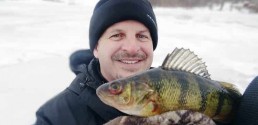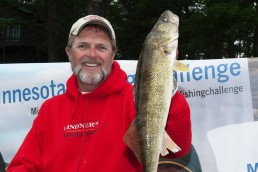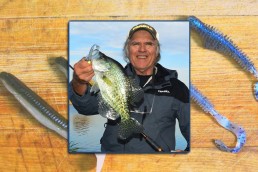Bulrushes, Stick-ups and Cabbage Weed Panfish
SHARE THIS POST
What do bulrushes, stick-ups, and cabbage weeds have in common? Panfish—lots of them, just prior to ice-over, at first ice and at ice-out. If you’ve fished the body of water during the summer, then you are likely familiar with their location.
The deeper the water bordering these structural elements, the better the area will be in drawing numbers of fish. In addition, you would like the actual fishing depth to be starting at 2 feet and going to 10 feet. Lilly pads are worth a quick peak and best fished with a long rod; dabble your bait between the pads.
Stick-ups normally stick out of the water. Most are found near a shoreline, and often a brushy one at that. On occasions they can be found out on a shallow bar or flat. In areas where visual sightings are found, there will be many more under the surface and out of plain sight.
This is where my Lowrance comes in handy. You can locate the submerged brush piles and the deep cabbage weeds quickly and efficiently. Submerged clumps of bulrushes pop out like a deer eyes in a headlight. Side scan/structure scan where you can watch a 100- to 125-foot swath, quickly pinpointing spots that other anglers likely will miss.
Locating the small areas off of the beaten path will lead to more fish. Remember that shallow-water fish are spooky. Ice anglers: He who cuts the most holes and uses his graph the best will normally catch the bulk of the early-season fish.
When fishing the bulrushes or cabbage weeds search out for the small open pockets. These pockets create edges that panfish love. Start on the shallow flat and slowly work your way to the deep-water edge as the sun rises or the fishing pressure takes hold. Reverse this process during the evening.
Think small and light. Use 1- or 2-pound-test line specially made for ice fishing. I use 4-pound-test fluorocarbon when open- water fishing. Try the smallest teardrops and plastic baits you can locate.
The delicate plastic baits are really catching on, and for good reason. They catch fish and changing color is much easier than changing a teardrop. Very little motion is required from the angler to entice a fish.
Often, a slight side-to-side shake is best, followed by 15 seconds of no movement. Raise your rod tip up and very slowly lower it down with plenty of pauses.
Great plastic baits include the Whip R Snap and Whip R Knocker. Excellent teardrops include the K @ E Tiny Tear, the Arnold Fairy Jig and Moxy Jig and the Moon Shad-O and Moon Glitter and Glow. All of these are available from Stopper Lures. Custom Jigs & Spins and Northland Tackle carry an unbelievable number of fine jigs and ice fishing teardrops.
A Gold Eagle Claw hook in a size 10-14 tipped with an Uncle Josh ice fleck is deadly. The ice-fleck is a favorite of many die-hard anglers either tipped on a teardrop or on a plain hook.
Use a titanium spring bobber when fishing the flats or along the first drop-off when ice fishing. Use a Lindy slip float for the open water and use the smallest, most sensitive float during the open-water trips. This extra sensitive bobber often will produce three times more fish than when fishing without a bobber or when using a pegged bobber.
If there’s access to deeper water, panfish will use it often. I love spikes, but when crappies are in the mix, carry minnows.
Lastly, drift or troll the first edge or drop-off. It might be only 8 to 12 feet, but work this edge slowly. I use my Driftmaster rod tree to drift or super-slow- troll. The rod tree offers pinpoint accuracy, and having three rods fanned out in front of you makes it easy to spot any change to a rod.
Are you enjoying this post?
You can be among the first to get the latest info on where to go, what to use and how to use it!
Stick-ups, bushes or wood of any type are a drawing card for crappies and ‘gills. Wintertime and early spring are my favorites, but 12 months out of the year, panfish will be found in wood, if present.
Standing timber in most of our lakes are visible. Brushy shorelines are also easily spotted, but some of the best brush might be under the ice during the winter. Early-season success is often found in mud-bottom areas, shallow water structure, canals and channels. Add the timber or brush and it becomes a real hot spot.
Cutting holes is the one thing that I hate, but the most important. At a brushy shoreline or an area of treetops, cut a series of holes. Six holes is a minimum, and depending on the size of your targeted area, or maybe even 10 holes is ideal.
Start fishing at the first hole and move down every few minutes if no action is found. If the action slows on a hole move down and return in 30 minutes. When fishing brush along a shoreline you normally catch a couple of fish from each brush pile.
Treetops that have numerous limbs might hold a limit of fish. In this case, you may need four holes to fish one tree. Early, the treetops closest to the shore produce the best; as winter takes hold, the tops closest to deep water produce best.
A stump field can be a combination of the two. Stumps most often are located away from the shoreline and in deeper water. They provide great year-round structure, but a good graph is needed in locating them. Once a stump field is found, a GPS becomes your best friend.
Backwaters of a river or a bayou almost always have brush along the shoreline. An undeveloped section of a lake will have logs, brush and debris near the shoreline or fallen trees that might reach the first drop-off.
Fallen trees create a canopy for the fish to hide under. The closer the drop-off is to the shoreline, the longer or larger the canopy will be. Vision a majestic 50-foot oak tree that fell into the lake. Twenty feet from shore the drop-off begins. Part of the tree will be hanging over the drop-off, creating perfect year-round cover.
If the snow is not too deep you can often spot these trees. Deep snow requires some luck and good usage of your graph. Open-water anglers should invest in a handheld GPS to mark these locations for the best winter action.
We like the tungsten jigs. They fall faster, which is nice when working deep water or when trying to get through some limbs. With a tungsten jig, a smaller profile can be used. Tungsten is heavier than lead, and these jigs fall quickly and will impart a nice side-to-side motion. The slick jig is really good on the stump fields and when the ‘gills are holding tight to the bottom. The easiest action is tapping your butt of your rod. The little shimmering action that comes from a love tap is all that’s needed for these tight cover-holding fish.
Bluegills require a smaller jig than crappies. Waxworms work great, but don’t forget the spikes. There is something about a spike or two dangling from a Skandia jig that draws on a curious fish.
Some of our favorite lakes in Michigan include Pine, Sessions, Houghton, Miner, White and Muskegon lakes, Lake Cadillac, Fletcher Pond and Genes Pond.
Think shallow water filled with some type of wood or vertical structure and you will land more fish at first ice or at ice-out.
MWO
SHARE THIS POST
Did you enjoy this post?
You can be among the first to get the latest info on where to go, what to use and how to use it!
Jack Payne
Jack Payne is an accomplished angler and hunter who enjoys teaching others as much as learning from others. Seminar speaker, outdoor photography enthusiast, hunter safety instructor and volunteer at many events for both kids and adults as an instructor.



